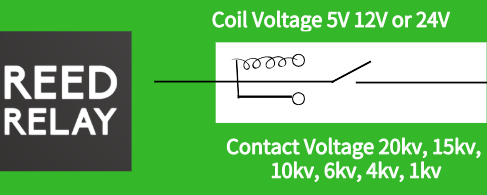The application of dry reed relays in discrete device testing equipment.
Under certain extreme conditions, testing high power discrete semiconductor devices may require pulse currents up to 100 amperes for testing, mainly to determine whether the device can withstand extreme currents without failure. At the same time, it can also verify whether the power chip is adequately matched to its substrate, and test its voltage tolerance. Since each component needs to undergo multiple tests with different voltages, currents, and detection equipment, isolation is crucial for each test. Isolation is generally achieved through switch devices. Due to the need for switch devices to constantly perform switching actions, which can exceed hundreds of millions of times, the reliability of switch devices is particularly important. Electromechanical equipment performs well in carrying high currents but begins to experience mechanical wear after 1 million operations. Semiconductor switch devices usually cannot simultaneously support high current and high voltage in a single chip. For the aforementioned reasons, designers have used some series of MiRelay dry reed relays to solve the problems that have arisen previously.
Take the HVFR-HI series of high voltage and high insulation dry reed relays as an example:
● Contact forms include 1A/2A/3A/4A
● Switching voltage up to 1KV, with instantaneous reaching 2KV
● Switching current of 1A, pulse current of 5A/10A/20A
● Withstand voltage above 3KV. Insulation resistance above 100T
● Switching time within 1.2ms, with a lifespan of more than 1 billion times
For the HVFR series dry reed relay, its switching voltage can reach 1000V. Due to the use of vacuum dry reed tubes, its dielectric strength can reach over 3000V. This series of products can switch low-level signals for billions of times and can withstand high current pulses of the same number of times. It can withstand a continuous current of 3A and a pulse current of 5A for 5 milliseconds without causing distortion to its front or rear edges. For higher pulse currents, it is recommended to wait at least 5 milliseconds after the coil is energized before applying a high pulse current. Pulse currents can enable designers to determine whether the chip is intact and whether it is accurately placed on the substrate to ensure its efficient operation. Therefore, the key to the problem is how to use a relay that only passes 5A of current to complete a test with a pulse current of 100A through a semiconductor device. Designers only need to use 20 dry reed relays in parallel with a power resistor, and connect each relay contact in series. The resistor distributes 100A of current equally among the 20 relays, thus achieving successful operation of high current pulses.
Application:
▪ Suitable for testing power discrete semiconductor devices such as TVS tubes
▪ Suitable for testing power MOS tubes, surge protectors, power transistors, etc.
